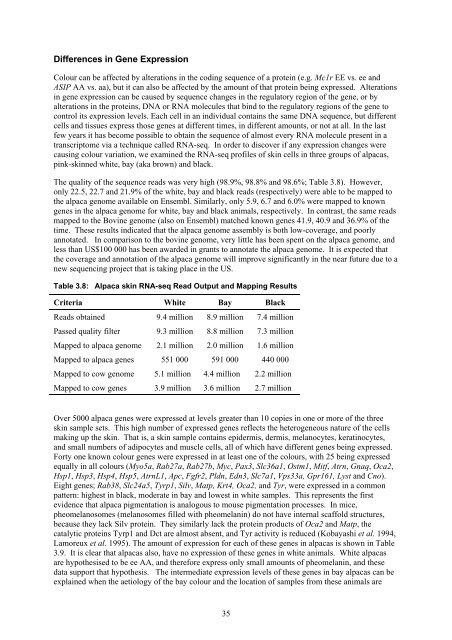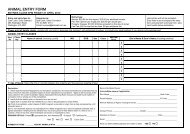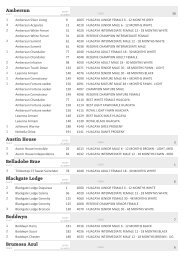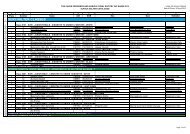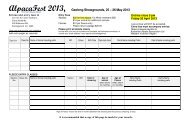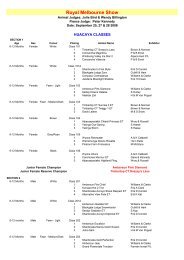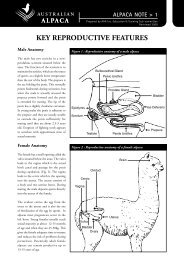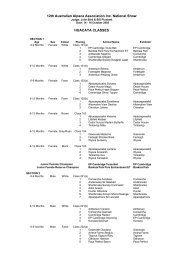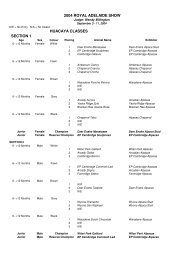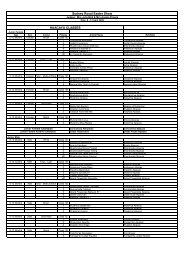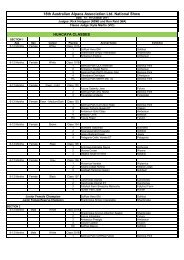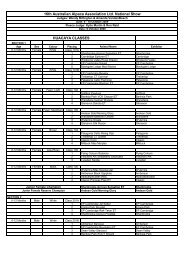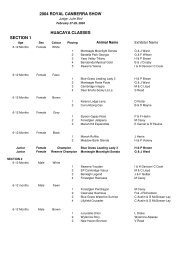Inheritance of White Colour in Alpacas - Australian Alpaca Association
Inheritance of White Colour in Alpacas - Australian Alpaca Association
Inheritance of White Colour in Alpacas - Australian Alpaca Association
Create successful ePaper yourself
Turn your PDF publications into a flip-book with our unique Google optimized e-Paper software.
Differences <strong>in</strong> Gene Expression<br />
<strong>Colour</strong> can be affected by alterations <strong>in</strong> the cod<strong>in</strong>g sequence <strong>of</strong> a prote<strong>in</strong> (e.g. Mc1r EE vs. ee and<br />
ASIP AA vs. aa), but it can also be affected by the amount <strong>of</strong> that prote<strong>in</strong> be<strong>in</strong>g expressed. Alterations<br />
<strong>in</strong> gene expression can be caused by sequence changes <strong>in</strong> the regulatory region <strong>of</strong> the gene, or by<br />
alterations <strong>in</strong> the prote<strong>in</strong>s, DNA or RNA molecules that b<strong>in</strong>d to the regulatory regions <strong>of</strong> the gene to<br />
control its expression levels. Each cell <strong>in</strong> an <strong>in</strong>dividual conta<strong>in</strong>s the same DNA sequence, but different<br />
cells and tissues express those genes at different times, <strong>in</strong> different amounts, or not at all. In the last<br />
few years it has become possible to obta<strong>in</strong> the sequence <strong>of</strong> almost every RNA molecule present <strong>in</strong> a<br />
transcriptome via a technique called RNA-seq. In order to discover if any expression changes were<br />
caus<strong>in</strong>g colour variation, we exam<strong>in</strong>ed the RNA-seq pr<strong>of</strong>iles <strong>of</strong> sk<strong>in</strong> cells <strong>in</strong> three groups <strong>of</strong> alpacas,<br />
p<strong>in</strong>k-sk<strong>in</strong>ned white, bay (aka brown) and black.<br />
The quality <strong>of</strong> the sequence reads was very high (98.9%, 98.8% and 98.6%; Table 3.8). However,<br />
only 22.5, 22.7 and 21.9% <strong>of</strong> the white, bay and black reads (respectively) were able to be mapped to<br />
the alpaca genome available on Ensembl. Similarly, only 5.9, 6.7 and 6.0% were mapped to known<br />
genes <strong>in</strong> the alpaca genome for white, bay and black animals, respectively. In contrast, the same reads<br />
mapped to the Bov<strong>in</strong>e genome (also on Ensembl) matched known genes 41.9, 40.9 and 36.9% <strong>of</strong> the<br />
time. These results <strong>in</strong>dicated that the alpaca genome assembly is both low-coverage, and poorly<br />
annotated. In comparison to the bov<strong>in</strong>e genome, very little has been spent on the alpaca genome, and<br />
less than US$100 000 has been awarded <strong>in</strong> grants to annotate the alpaca genome. It is expected that<br />
the coverage and annotation <strong>of</strong> the alpaca genome will improve significantly <strong>in</strong> the near future due to a<br />
new sequenc<strong>in</strong>g project that is tak<strong>in</strong>g place <strong>in</strong> the US.<br />
Table 3.8: <strong>Alpaca</strong> sk<strong>in</strong> RNA-seq Read Output and Mapp<strong>in</strong>g Results<br />
Criteria <strong>White</strong> Bay Black<br />
Reads obta<strong>in</strong>ed 9.4 million 8.9 million 7.4 million<br />
Passed quality filter 9.3 million 8.8 million 7.3 million<br />
Mapped to alpaca genome 2.1 million 2.0 million 1.6 million<br />
Mapped to alpaca genes 551 000 591 000 440 000<br />
Mapped to cow genome 5.1 million 4.4 million 2.2 million<br />
Mapped to cow genes 3.9 million 3.6 million 2.7 million<br />
Over 5000 alpaca genes were expressed at levels greater than 10 copies <strong>in</strong> one or more <strong>of</strong> the three<br />
sk<strong>in</strong> sample sets. This high number <strong>of</strong> expressed genes reflects the heterogeneous nature <strong>of</strong> the cells<br />
mak<strong>in</strong>g up the sk<strong>in</strong>. That is, a sk<strong>in</strong> sample conta<strong>in</strong>s epidermis, dermis, melanocytes, kerat<strong>in</strong>ocytes,<br />
and small numbers <strong>of</strong> adipocytes and muscle cells, all <strong>of</strong> which have different genes be<strong>in</strong>g expressed.<br />
Forty one known colour genes were expressed <strong>in</strong> at least one <strong>of</strong> the colours, with 25 be<strong>in</strong>g expressed<br />
equally <strong>in</strong> all colours (Myo5a, Rab27a, Rab27b, Myc, Pax3, Slc36a1, Ostm1, Mitf, Atrn, Gnaq, Oca2,<br />
Hsp1, Hsp3, Hsp4, Hsp5, AtrnL1, Apc, Fgfr2, Pldn, Edn3, Slc7a1, Vps33a, Gpr161, Lyst and Cno).<br />
Eight genes; Rab38, Slc24a5, Tyrp1, Silv, Matp, Krt4, Oca2, and Tyr, were expressed <strong>in</strong> a common<br />
pattern: highest <strong>in</strong> black, moderate <strong>in</strong> bay and lowest <strong>in</strong> white samples. This represents the first<br />
evidence that alpaca pigmentation is analogous to mouse pigmentation processes. In mice,<br />
pheomelanosomes (melanosomes filled with pheomelan<strong>in</strong>) do not have <strong>in</strong>ternal scaffold structures,<br />
because they lack Silv prote<strong>in</strong>. They similarly lack the prote<strong>in</strong> products <strong>of</strong> Oca2 and Matp, the<br />
catalytic prote<strong>in</strong>s Tyrp1 and Dct are almost absent, and Tyr activity is reduced (Kobayashi et al. 1994,<br />
Lamoreux et al. 1995). The amount <strong>of</strong> expression for each <strong>of</strong> these genes <strong>in</strong> alpacas is shown <strong>in</strong> Table<br />
3.9. It is clear that alpacas also, have no expression <strong>of</strong> these genes <strong>in</strong> white animals. <strong>White</strong> alpacas<br />
are hypothesised to be ee AA, and therefore express only small amounts <strong>of</strong> pheomelan<strong>in</strong>, and these<br />
data support that hypothesis. The <strong>in</strong>termediate expression levels <strong>of</strong> these genes <strong>in</strong> bay alpacas can be<br />
expla<strong>in</strong>ed when the aetiology <strong>of</strong> the bay colour and the location <strong>of</strong> samples from these animals are<br />
35


